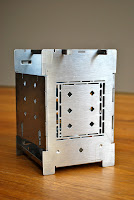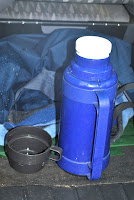It's a gadget and it involves cooking, what's not to like? And even the £11.16 customs charge that I needed to pay to get it out of the sorting office didn't dent my enthusiasm to put it through it's paces.So on a bright cold morning I was out in the garden frying sausages. I'd seen the stove on Twitter. It's proudly made in America apparently and called a Firebox fromfoldingfirebox.com.
As a small aside, I think that sustainability is going to become more and more important in everything we do. The days of using, then dumping, gas cylinders in some of the most remote parts of the planet needs to stop. And in that sense this stove scores highly.
But I was most interested in good old fashioned sticks, so went out in the garden to see what was lying around in the shed. A range of sticks and cuttings - bits of old grape vine, bay tree twigs - you name it. Crumpling up a couple of sheets of newspaper in the base and then dumping in sticks pretty randomly, one match later and we had lift off. Sadly time was pressing, so my cooking was limited to frying up some chipolatas for lunch - hardly a real test.
But one thing it did show was the build strength. My frying pan of choice was the upturned lid of my trusty dutch oven. Made of cast iron, it distributes heat really well. But of course is a little on the heavy side! The Firebox was perfectly stable and even with quite an overhang it was pretty easy to add in extra fuel with burning fingers. Even a few twigs throws out a decent heat and the walls ensure that that this is directed where it needs to go.
So 20 or so minutes later and a dozen chipolatas plus a couple of field mushrooms were ready.
Where I think this stove will really come into it's own is when I'm trying to travel light. The thought of being able to leave behind fuel bottles and just use a few sticks I find on the way is really appealing to me (and to my wallet). It does of course mean that I will need to check that my route includes a copse or wood, but I think even my navigation skills are up to the task.
I'm intending to write about the Folding Firebox later, but initial impressions are pretty good. Not sure I could cook Christmas lunch on it though......but you never know.























